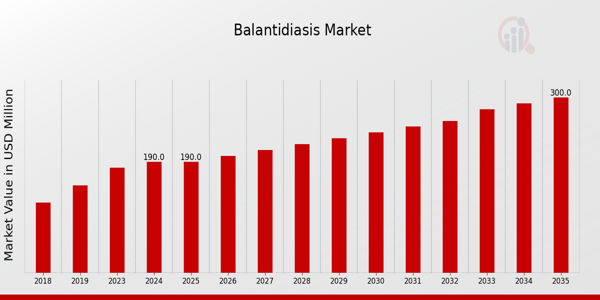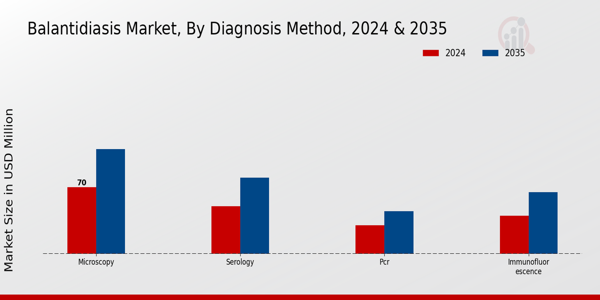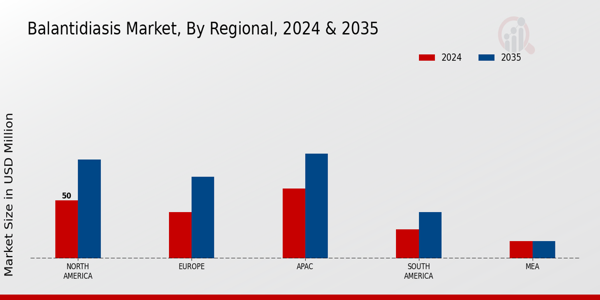Global Balantidiasis Market Overview
As per MRFR analysis, the Balantidiasis Market Size was estimated at 180 (USD Million) in 2023.The Balantidiasis Market is expected to grow from 190(USD Million) in 2024 to 300 (USD Million) by 2035. The Balantidiasis Market CAGR (growth rate) is expected to be around 4.43% during the forecast period (2025 - 2035).
Key Balantidiasis Market Trends Highlighted
The growing focus on public health activities and the growing awareness of zoonotic illnesses are driving significant trends in the balantidiasis market. The necessity for efficient management and control measures is highlighted by the prevalence of balantidiasis, which is found mostly in regions where pigs are reared and eaten.
Global health organizations can greatly improve disease prevention and control strategies by working to improve sanitation and hygiene in vulnerable areas. The market is also driven by the demand for prompt diagnostics and treatment alternatives, with an increasing focus on creating rapid testing procedures.
New treatments and preventative strategies are being developed as a result of continuous research and development to better understand the lifecycle of Balantidium coli. Especially in endemic areas, public-private sector cooperation is essential to advancing programs that increase healthcare access and knowledge.
Furthermore, more money is being allocated to healthcare research, which encourages developments in the area and may open up new business opportunities. A One Health approach is shown in recent trends that show a move toward integrated health solutions that take into account the linkages between human and animal health.
This all-encompassing perspective promotes spending on veterinary care and surveillance in order to efficiently monitor illness trends. To reduce the risk of balanidiasis epidemics, the nexus of public health, veterinary medicine, and agriculture is becoming more and more important.
The balantidiasis market is expected to develop and expand in the upcoming years as governments give priority to these interrelated areas.

Source: Primary Research, Secondary Research, MRFR Database and Analyst Review
Balantidiasis Market Drivers
Increasing Incidence of Balantidiasis Cases Globally
The rising number of Balantidiasis cases is a significant driver of the balantidiasis market. According to the World Health Organization, Balantidiasis is primarily associated with poor sanitation and hygiene practices, particularly in developing countries.
A report indicates that over 1 percent of livestock in these regions contributes to the infection spread among humans, emphasizing that approximately 300 million people live in poverty, which puts them at higher risk of infection.
This demographic is expected to fuel demand for diagnostic tools and treatment options, hence encouraging market growth. Furthermore, global initiatives led by various health organizations focus on improving sanitation, which indirectly raises awareness for Balantidiasis treatment and creates market opportunities.
Research and Development Activities in Treatment Options
Active Research and Development efforts to discover better treatment options for Balantidiasis are propelling the balantidiasis market forward. Pharmaceutical companies are investing significantly in innovative drug development; for instance, clinical trials and research supported by institutions such as the National Institutes of Health have shown a growing interest in effective therapies.
Emerging research suggests that new compounds are being evaluated for their efficacy in treating Balantidiasis, which can enhance treatment options available to healthcare providers. With an ongoing increase in funding for Health Research and Development, estimated to reach over 200 billion USD globally by 2025, the market for Balantidiasis treatments is likely to benefit considerably.
Government Initiatives to Combat Infectious Diseases
Government initiatives aimed at controlling infectious diseases directly influence the balantidiasis market. Various countries are implementing health programs designed to eradicate diseases caused by parasites and pathogens, including Balantidiasis.
For instance, programs under the Global Fund to Fight AIDS, Tuberculosis, and Malaria (GFATM) underscore the necessity of addressing conditions prevalent in affected populations.
With commitments towards universal health coverage, governments are proactively funding campaigns to raise awareness and mobilize treatment approaches, which in turn elevates the significance of Balantidiasis treatments within public health agendas. The investments from governments are projected to increase, which will subsequently enhance market prospects.
Balantidiasis Market Segment Insights
Balantidiasis Market Diagnosis Method Insights
The balantidiasis market, focusing on the Diagnosis Method segment, experienced a noteworthy trajectory of growth driven by advancements in diagnostic techniques and rising awareness of the disease.
Within this segment, Microscopy stood as a prominent technique, with a valuation of 70.0 USD Million in 2024 and expected to rise to 110.0 USD Million by 2035, illustrating its vital role in direct observation of the parasite in stool samples. This conventional method provided clinicians with critical, immediate insights for diagnosis.
Serology was another crucial method, valued at 50.0 USD Million in 2024 and reaching to 80.0 USD Million by 2035, showcasing its significance in detecting antibodies to the pathogen, which not only helped in diagnosing current infections but also in understanding immune responses in affected populations.
Immunofluorescence, valued at 40.0 USD Million in 2024 and projected to grow to 65.0 USD Million by 2035, gained traction due to its specificity and sensitivity in identifying Balantidium coli in clinical samples, making it a reliable choice for healthcare professionals.
Finally, PCR, valued at 30.0 USD Million in 2024 and anticipated to grow to 45.0 USD Million by 2035, represented a cutting-edge diagnostic approach, allowing for rapid detection of genomic material from the pathogen, thereby substantially reducing time-to-diagnosis.
The diverse and evolving Diagnostic Method segment reflected the growing investments and innovations aimed at enhancing Balantidiasis detection, ultimately driving improved patient outcomes on a global scale. Enhanced awareness and ongoing Research and Development efforts in diagnostics presented opportunities for significant advancements in the field, shaping the balantidiasis market dynamics.

Source: Primary Research, Secondary Research, MRFR Database and Analyst Review
Balantidiasis Market Treatment Type Insights
The balantidiasis market is experiencing growth driven by various treatment types, which play a crucial role in addressing this parasitic infection. The Treatment Type category comprises prominent approaches such as Antibiotics, Antimicrobials, and Combination Therapy, with each method tailored to enhance recovery and treat symptoms effectively.
Antibiotics are favored for their effectiveness in targeting the specific pathogen responsible for the infection, while Antimicrobials broaden the scope of treatment options and support various therapeutic strategies.
Combination Therapy is gaining traction due to its potential to enhance efficacy and reduce resistance, demonstrating the importance of utilizing multiple treatment agents. The rising prevalence of Balantidiasis, particularly in regions with inadequate sanitation and hygiene, creates considerable demand for these treatment modalities, thus influencing the balantidiasis market revenue.
Increased awareness and ongoing public health initiatives contribute to bridging the treatment gap and highlighting the significance of the treatment types that dominate this market. As a result, these factors collectively shape the landscape of the balantidiasis market and its Treatment Type segment.
Balantidiasis Market End User Insights
The End User segment plays a crucial role in shaping market dynamics, particularly through Hospitals, Clinics, and Research Laboratories, which are essential for diagnosing and treating Balantidiasis. Hospitals hold a vital position in patient care, providing advanced medical treatments and resources necessary for managing this parasitic infection.
Clinics contribute significantly to early detection and small-scale management of cases, enabling quicker patient access to treatment. Research Laboratories are vital for conducting studies and developing new diagnostic tools, treatments, and preventative measures.
As global health continues to focus on infectious diseases, the demand in these segments is driven by increasing awareness, improved diagnostic capabilities, and a growing number of research initiatives aimed at eradicating Balantidiasis.
The overall landscape reflects a growing commitment to enhancing public health responses to parasitic diseases, thereby offering numerous opportunities for market participants to innovate and expand their healthcare solutions.
Balantidiasis Market Route of Administration Insights
The balantidiasis market is experiencing notable growth driven by various routes of administration, which play a crucial role in treatment effectiveness. The primary routes of administration include Oral, Intravenous, and Intramuscular, each contributing to patient compliance and therapeutic outcomes in different ways.
The Oral route is widely recognized for its ease of administration and high patient preference, leading to significant adoption in outpatient settings. Meanwhile, Intravenous administration is critical for rapid action in severe cases, ensuring immediate medication effects, thus holding a significant position in hospital environments.
The Intramuscular route provides a balance between efficacy and patient comfort, often utilized in collaborative care settings. Increased awareness of Balantidiasis and advancements in treatment options are driving the market forward, while challenges like accessibility in rural areas present opportunities for growth, fostering the need for diversified administration strategies.
The balantidiasis market segmentation reflects these dynamics, emphasizing the importance of tailored treatment approaches.
Balantidiasis Market Regional Insights
The balantidiasis market showcased diverse regional dynamics, with North America, Europe, APAC, South America, and MEA as key contributors. In 2024, North America held a valuation of 50.0 USD Million, expected to grow to 85.0 USD Million by 2035, indicating significant market potential.
Europe followed with a valuation of 40.0 USD Million in 2024, projected to reach 70.0 USD Million in 2035, showcasing its strong research and development activities in this area.
APAC demonstrated robust growth potential, valued at 60.0 USD Million in 2024 and expected to reach 90.0 USD Million by 2035, as it held a large population susceptible to Balantidiasis, presenting substantial opportunities for healthcare initiatives.
South America, with a valuation of 25.0 USD Million in 2024, and MEA, valued at 15.0 USD Million, also played important roles in the overall region, although healthcare infrastructure challenges persist.
The high prevalence of Balantidiasis in these regions underscored the necessity for increased awareness and intervention strategies. These regional variations indicated a dynamic balantidiasis market with varying degrees of opportunity and growth drivers tailored to local health policies and demographic concerns.

Source: Primary Research, Secondary Research, MRFR Database and Analyst Review
Balantidiasis Market Key Players and Competitive Insights
The balantidiasis market is characterized by a competitive landscape influenced by a variety of players aiming to address this parasitic disease, primarily caused by Balantidium coli. As awareness surrounding neglected tropical diseases increases, the demand for effective treatment options is also growing.
Companies involved in this domain are focused on research and development initiatives, aiming to advance therapeutic solutions and improve market share. The competitive environment is not only shaped by established pharmaceutical giants but also by smaller biotechnology firms aiming to innovate and provide specialized solutions.
Collaboration with research institutions and strategic partnerships are common strategies employed within this market to leverage expertise and enhance product offerings. Additionally, geographical variations in disease prevalence have led to diverse market dynamics and a need for tailored approaches to treatment.
Pfizer has established a significant presence within the balantidiasis market, primarily recognized for its extensive portfolio of pharmaceutical products and commitment to innovation. The company possesses a robust research framework that facilitates the development of effective treatments, which is crucial for addressing the needs associated with Balantidiasis.
Pfizer’s strengths lie in its advanced manufacturing capabilities and its extensive distribution networks, which ensure timely availability of treatment options across various regions. The company's focus on patient education and awareness campaigns further enhances its market position, allowing it to engage with healthcare professionals and patients effectively.
The integration of advanced technologies in drug development and the deployment of clinical trials to validate new therapeutic approaches are also key strengths for Pfizer in this arena. Roche plays a pivotal role in the balantidiasis market through its dedication to advancing medical science with innovative healthcare solutions.
The company is well-regarded for its research and development capabilities, making it a leading player in the biopharmaceutical sector. Roche’s strengths in diagnostics and its ability to leverage genomic insight have proven beneficial in developing targeted therapeutic solutions for infections, including Balantidiasis.
The company's portfolio includes a range of products that address diverse health challenges, emphasizing personalized medicine. Roche is proactive in pursuing strategic mergers and acquisitions to enhance its capabilities and expand its market reach globally.
By aligning with other organizations and research-centric entities, Roche enhances its capacity to develop effective interventions for Balantidiasis while also fortifying its position within global health initiatives. This commitment to advancing healthcare and addressing unmet medical needs showcases Roche's strategic importance in the market.
Key Companies in the Balantidiasis Market Include:
- Pfizer
- Roche
- AbbVie
- Eli Lilly
- Boehringer Ingelheim
- Johnson and Johnson
- Gilead Sciences
- Novartis
- Teva Pharmaceuticals
- Bristol-Myers Squibb
- Merck
- AstraZeneca
- GlaxoSmithKline
- Amgen
- Sanofi
Balantidiasis Market Developments
Recent news developments in the balantidiasis market highlight ongoing efforts in drug development and increasing awareness of the disease, often linked to poor sanitation in tropical regions. Companies such as Pfizer, Roche, AbbVie, and Gilead Sciences are actively investing in Research and Development to address the challenges posed by Balantidiasis.
Current affairs indicate a heightened focus on education and prevention measures to combat this parasitic infection, along with innovations in treatment protocols being introduced by pharmaceutical giants like Johnson and Johnson and Merck.
There have been no significant recent mergers or acquisitions within this specific market sector involving key players such as Amgen, AstraZeneca, or GlaxoSmithKline, ensuring stability in their product portfolios.
Over the past couple of years, initiatives to promote sustainable health solutions have gained traction, especially in regions where Balantidiasis is endemic.
Furthermore, the market's valuation has been influenced by advancements in diagnostics and therapeutics that enhance treatment efficacy, while partnerships among companies enhance resource sharing in tackling public health challenges related to Balantidiasis globally.
Balantidiasis Market Segmentation Insights
-
Balantidiasis Market Diagnosis Method Outlook
- Microscopy
- Serology
- Immunofluorescence
- PCR
-
Balantidiasis Market Treatment Type Outlook
- Antibiotics
- Antimicrobials
- Combination Therapy
-
Balantidiasis Market End User Outlook
- Hospitals
- Clinics
- Research Laboratories
-
Balantidiasis Market Route of Administration Outlook
- Oral
- Intravenous
- Intramuscular
-
Balantidiasis Market Regional Outlook
- North America
- Europe
- South America
- Asia Pacific
- Middle East and Africa
| Report Attribute/Metric Source: |
Details |
| MARKET SIZE 2023 |
180.0(USD Million) |
| MARKET SIZE 2024 |
190.0(USD Million) |
| MARKET SIZE 2035 |
300.0(USD Million) |
| COMPOUND ANNUAL GROWTH RATE (CAGR) |
4.43% (2025 - 2035) |
| REPORT COVERAGE |
Revenue Forecast, Competitive Landscape, Growth Factors, and Trends |
| BASE YEAR |
2024 |
| MARKET FORECAST PERIOD |
2025 - 2035 |
| HISTORICAL DATA |
2019 - 2024 |
| MARKET FORECAST UNITS |
USD Million |
| KEY COMPANIES PROFILED |
Pfizer, Roche, AbbVie, Eli Lilly, Boehringer Ingelheim, Johnson and Johnson, Gilead Sciences, Novartis, Teva Pharmaceuticals, BristolMyers Squibb, Merck, AstraZeneca, GlaxoSmithKline, Amgen, Sanofi |
| SEGMENTS COVERED |
Diagnosis Method, Treatment Type, End User, Route of Administration, Regional |
| KEY MARKET OPPORTUNITIES |
Increasing prevalence in developing regions, Advancements in diagnostic techniques, Emerging therapies and treatments, Growing awareness and education, Enhanced public health initiatives |
| KEY MARKET DYNAMICS |
Increasing prevalence of infection, Growing awareness and education, Advancements in diagnostic techniques, Availability of effective treatments, Government initiatives for healthcare access |
| COUNTRIES COVERED |
North America, Europe, APAC, South America, MEA |
Balantidiasis Market Highlights:
Frequently Asked Questions (FAQ) :
The Global Balantidiasis Market is expected to be valued at 190.0 USD Million in 2024.
By 2035, the Global Balantidiasis Market is anticipated to reach a value of 300.0 USD Million.
The expected CAGR for the Global Balantidiasis Market from 2025 to 2035 is 4.43%.
The Microscopy segment is projected to have the highest market value at 70.0 USD Million in 2024.
The Serology segment is expected to reach 80.0 USD Million by 2035.
North America is projected to dominate the market with a value of 85.0 USD Million by 2035.
The APAC region is expected to have a market size of 60.0 USD Million in 2024.
Major players in the Global Balantidiasis Market include Pfizer, Roche, AbbVie, Eli Lilly, and Boehringer Ingelheim.
The Immunofluorescence segment is projected to reach 65.0 USD Million by 2035.
The South America region is expected to have a market value of 25.0 USD Million in 2024.


















